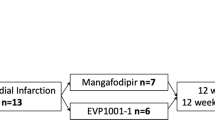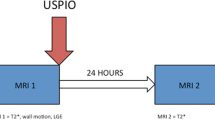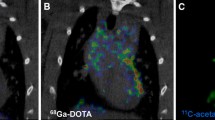Abstract
In previous experiments in tumors we demonstrated that metalloporphyrins are particularly avid for nonviable tumor components. This study was performed to find out wether these agents can be used as MRI contrast agents for the visualization of acute myocardial infarction (MI). A total of 44 rats, 6 normal controls and 38 with occlusive MI (2–24 h old), were used. Gadolinium mesopophyrin (Gd-MP) or manganese totraphenylporphyrin (Mn-TPP) was intravenously injected at doses of 0.1, 0.05, and 0.01 mmol.kg. Three to 24 h after injection, axial and coronal T1-weighted (TR/TE 300/15 ms) spinecho MR images were obtained before and after killing the animals and correlated with triphenyl tetrazolium chloride (TTC) histocemical preparations. The Gd-MP content in infarcted and noninfarcted myocardium was measured using inductively coled plasma atomic emission spectroscopy (ICP-AES) MRI without contrast media could not discern the MI. However, 3–24 h after injection of either Gd-MP or Mn-TPP, the infarcted area was positively stained on MR images. This area matched well witht he negatively TTC-stained area on the heart slices (r = 0.97). The contrast ratios between the infarcted nectrotic myocardium and the noninfarcted regions varied from 150 to 300% depending on the tye of agensts and doses used. Neither false-positive nor false-negative findings were encountered. The metallaporphyrin concentration was more than 10 times higher in the infarcted than in the noninfarcted heart. Metalloporphyrins appear to be promising MRI contrast agents for detection and quantification of necrosis in MI. These preclinical results may open new perspectives in cardiac imaging.
Similar content being viewed by others
References
American Heart Association (1989) 1990 heart and stroke facts. American Heart Association, Dallas, TX, USA pp 1–44
Roberts R, Kleiman NS (1994) Earlier diagnosis and treatment of acute myocardial infarction necessitates the need for a “new diagnostic mind-set”. Circulation 89: 872–881
Kaul S, Pandian NG, Gillam LD et al. (1986) Contrast echocardiography in acute myocardial ischemia: III. An in-vivo comparison of the extent of abnormal wall motion with the “area at risk” for necrosis. J Am Coll Cardiol 7: 383–392
Zaret BL, Wackers FJ (1993) Nuclear cardiology (review). N Engl J Med 329: 775–783
Johnston D, Thompson R, Liu P (1986) Magnetic resonance imaging during acute myocardial infarction. Am J Cardiol 58: 214–219
Saeed M, Wendland M, Takehara Y, Masui T, Higgins C (1992) Reperfusion and irreversible myocardial injury: identification with a nonionic MR imaging contrast medium. Radiology 182: 675–683
Weissleder R, Lee A, Khaw BN, Shen T, Brady T (1992) Antimyosin-labeled monocrystalline iron oxide allows detection of myocardial infarct: MR antibody imaging. Radiology 182: 381–385
Nelson J, Schmiedl U, Shankland E (1990) Metalloporphyrins as tumor-seeking MRI contrast media and as potential selective treatment sensitizers. Invest Radiol 25: S71-S73
Ogan M, Revel D, Brasch R (1987) Metalloporphyrin contrast enhancement of tumors in magnetic resonance imaging. A study of human carcinoma, lymphoma, and fibrosarcoma in mice. Invest Radiol 22: 822–828
van Zijl PCM, Place DA, Cohen JS, Faustino PJ, Lyon RC, Patronas NJ (1990) Metalloporphyrin magnetic resonance contrast agents: feasibility of tumor-specific magnetic resonance imaging. Acta Radiol Suppl (Stockh) 374: 75–79
Hindre F, LePlouzennec M, Certaines JD de, Foultier MT, Patrice T, Simonneaux G (1993) Tetra-p-amonophenylporphyrin conjugated with Gd-DTPA: tumor-specific contrast agent for MR imaging. J Magn Reson Imaging 3(1): 59–65
Young SW, Sidhu MK, Qing F, Muller HH, Neuder M, Zanassi G, Mody T, Hammi G, Dow W, Mutch JD, Sessler JL, Miller RA (1994) Preclinical evaluation of gadolinium (III) texaphyrin complex: a new paramagnetic contrast agent for magnetic resonance imaging. Invest Radiol 29: 330–338
Hilger CS, Maier FK, Ebert W Lee-Vaupel M, Niedballa U, Gaida J, Conrad J. German patent DE 42 32 925 A1, September 28, 1992
Maier FK, Ebert W, Lee-Vaupel M, Conrad J, Gries H. German patent DE 43 05 523 Al, February 17, 1993
Ni Y, Marchal G, Yu J, Lukito G, Petré C, Wevers M, Baert AL, Ebert W, Hilger CS, Maier FK, Semmler W (1995) Localization of metalloporphyrin induced “specific” enhancement in experimental liver tumors: comparison of MRI, microangiographic and histologic findings. Acad Radiol 2: 687–699
Ni Y (1995) Development and application of a methodology for preclinical evaluation of tissue specific MRI contrast media. Dissertation of the Ph.D. degree, Faculty of Medicine, Katholieke Universiteit Leuven, Belgium
Selye H, Bajusz E, Grasso S, Mendell P (1960) Simple technique for the surgical occlusion of coronary vessels in the rat. Angiology 11: 398–407
Fishbein M, Meerbaum S, Rit J, Lando U, Kanmatsuse K, Mercier M (1981) Early phase acute myocardial infarct size quantification: validation of the triphenyl tetrazolium chloride tissue enzyme staining technique. Am Heart J 101: 593–600
Saeed M, Wendland M, Masui T, Yu KK, Li J, Derugin N, Higgins CB (1993) Dual mechanisms for change in myocardial signal intensity by means of a single MR contrast medium: dependence on concentration and pulse sequence. Radiology 186: 175–182
Goldman MR, Brady TJ, Pykett IL, Burt CT, Buonanno FS, Kistler JP, Newhouse JH, Hinshow WS, Pohost GM (1982) Quantifications of experimental myocardial infarction using nuclear magnetic resonance imaging and paramagnetic ion contrast enhancement in exciseal canine hearts. Circulation 66: 1012–1016
Karlson BW, Herlitz J, Wiklund O et al. (1991) Early prediction of acute myocardial infarction from clinical history, examination, and electrocardiogram in the emergency room. Am J Cardiol 68: 171–175
Apple FS (1992) Acute myocardial infarction and coronary reperfusion: serum cardiac markers for the 1990s. Am J Clin Pathol 97: 85–89
Flameng W, Lesaffre E, Vanhaecke J (1990) Determinants of infarct size in non-human primates. Basic Res Cardiol 85: 392–403
Rahimtoola SH (1989) The hibernating myocardium. Am Heart J 117: 211–221
Braunwald E, Kloner RA (1982) The stunned myocardium: prolonged, postischemic ventricular dysfunction. Circulation 66: 1146–1149
Bergman SR (1991) Positron emission tomography of the heart. In: Gerson MC (eds) Cardiac nuclear medicine, 2nd edn. McGraw-Hill, New York, pp 299–336
Adzamli IK, Blau M, Pfeffer MA, Davis MA (1993) Phosphonate-modified Gd-DTPA complexes. III: the detection of myocardial infarction by MRI. Magn Reson Med 29: 505–511
McNamara MT, Higgins CB, Ehman RL, Revel D, Sievers R, Brasch RC (1984) Acute myocardial ischemia: magnetic resonance contrast enhancement with gadolinium-DTPA. Radiology 153: 157
Schmiedl U, Moseley M, Sievers R, Organ MD, Chew WM, Engeseth H, Finfbeiner WE, Lipton MJ, Brasch RC (1987) Magnetic resonance imaging of myocardial infarction using albumin-(Gd-DTPA), a macromolecular blood-volume contrast agent in a rat model. Invest Radiol 22: 713–721
Khaw BA, Strauss HW, Moore R, Fallon JT, Yasuda T, Gold HK, Haber E (1987) Myocardial damage delineated by indium-111 antimyosin Fab and technetium-99m pyrophosphate. J Nucl Med 28: 76–82
Nelson J, Schmiedl U (1991) Porphyrins as contrast media. Magn Reson Med 22:366–371
Author information
Authors and Affiliations
Rights and permissions
About this article
Cite this article
Marchal, G., Ni, Y., Herijgers, P. et al. Paramagnetic metalloporphyrins: infarct avid contrast agents for diagnosis of acute myocardial infarction by MRI. Eur. Radiol. 6, 2–8 (1996). https://doi.org/10.1007/BF00619942
Received:
Revised:
Accepted:
Issue Date:
DOI: https://doi.org/10.1007/BF00619942




